An Analysis of Leadership in Early Childhood Settings: ELCC 225
VerifiedAdded on 2022/11/01
|9
|2148
|344
Report
AI Summary
This report provides a detailed analysis of leadership in early childhood settings, focusing on various leadership styles such as task master, motivational, and comrade leaders, as well as distributive leadership. It explores the qualities of effective leaders, emphasizing the importance of ethics, particularly in relation to the care of young children. The report also discusses the diversity of leadership, including the creation of culturally diverse classroom environments, and addresses the historical context of early childhood education. Furthermore, it examines the political challenges faced by leaders in the ELCC field in Canada, such as lack of societal support and funding issues. The report concludes by highlighting the need for flexible and encouraging leadership approaches that prioritize teacher encouragement, sensitivity, and creativity.
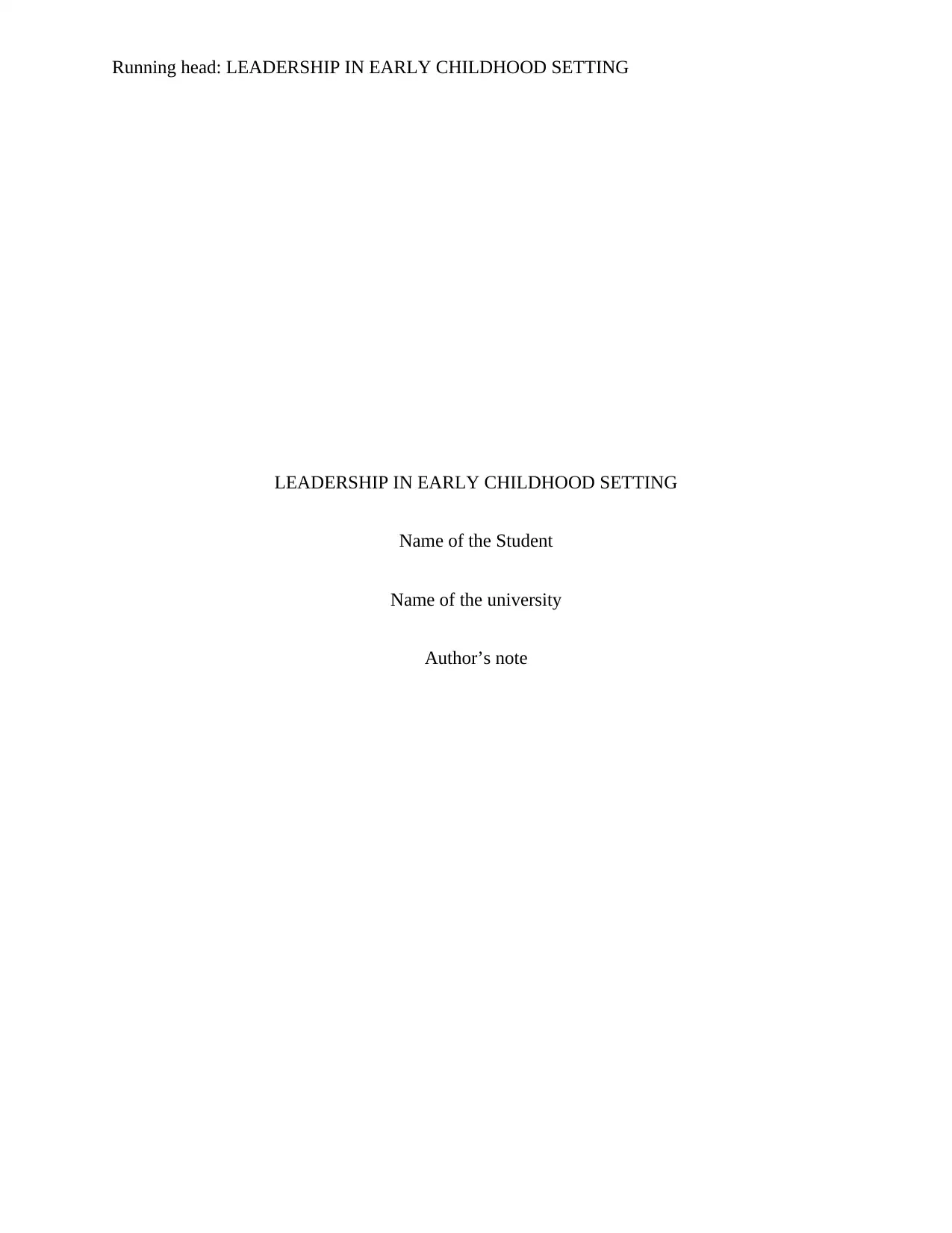
Running head: LEADERSHIP IN EARLY CHILDHOOD SETTING
LEADERSHIP IN EARLY CHILDHOOD SETTING
Name of the Student
Name of the university
Author’s note
LEADERSHIP IN EARLY CHILDHOOD SETTING
Name of the Student
Name of the university
Author’s note
Paraphrase This Document
Need a fresh take? Get an instant paraphrase of this document with our AI Paraphraser
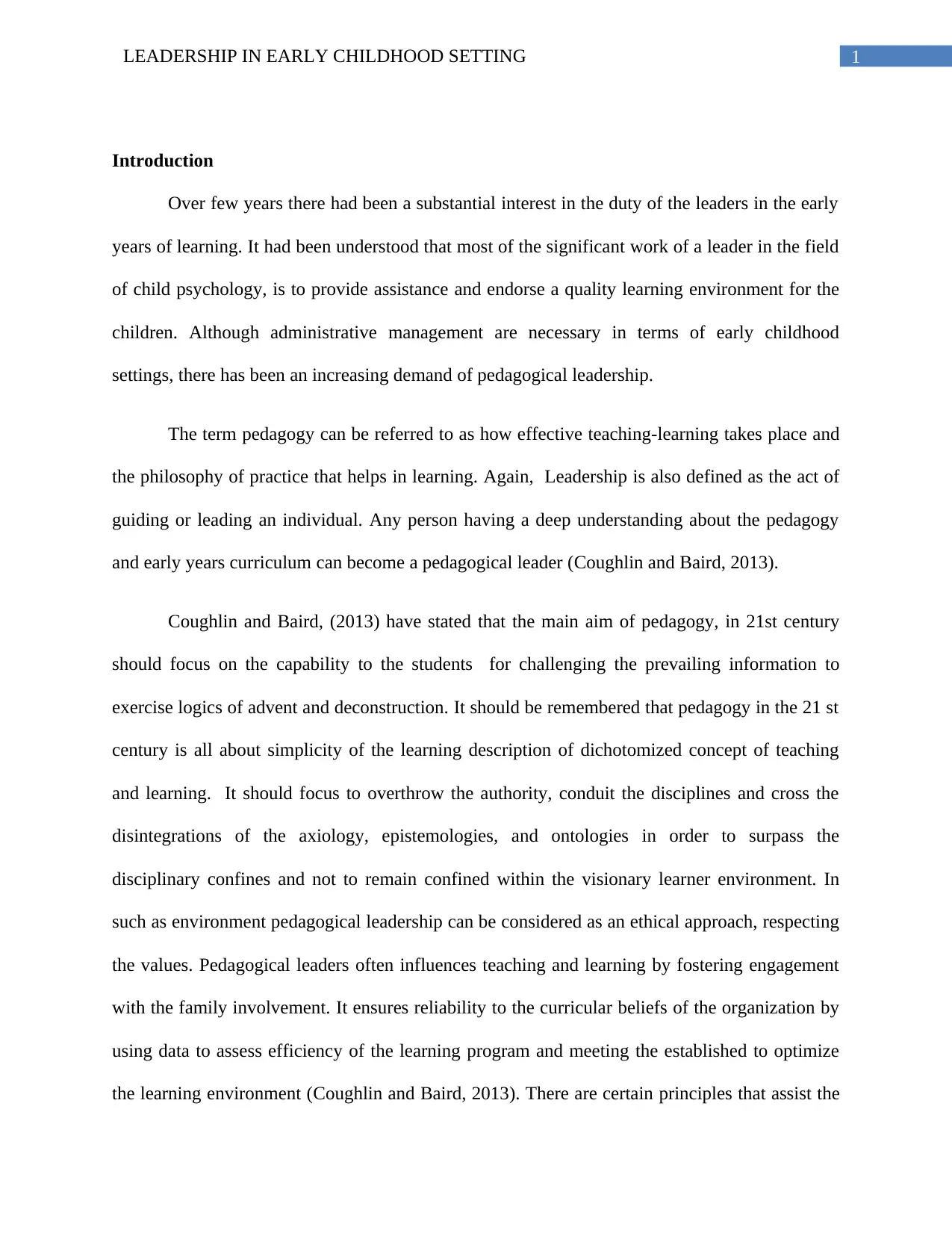
1LEADERSHIP IN EARLY CHILDHOOD SETTING
Introduction
Over few years there had been a substantial interest in the duty of the leaders in the early
years of learning. It had been understood that most of the significant work of a leader in the field
of child psychology, is to provide assistance and endorse a quality learning environment for the
children. Although administrative management are necessary in terms of early childhood
settings, there has been an increasing demand of pedagogical leadership.
The term pedagogy can be referred to as how effective teaching-learning takes place and
the philosophy of practice that helps in learning. Again, Leadership is also defined as the act of
guiding or leading an individual. Any person having a deep understanding about the pedagogy
and early years curriculum can become a pedagogical leader (Coughlin and Baird, 2013).
Coughlin and Baird, (2013) have stated that the main aim of pedagogy, in 21st century
should focus on the capability to the students for challenging the prevailing information to
exercise logics of advent and deconstruction. It should be remembered that pedagogy in the 21 st
century is all about simplicity of the learning description of dichotomized concept of teaching
and learning. It should focus to overthrow the authority, conduit the disciplines and cross the
disintegrations of the axiology, epistemologies, and ontologies in order to surpass the
disciplinary confines and not to remain confined within the visionary learner environment. In
such as environment pedagogical leadership can be considered as an ethical approach, respecting
the values. Pedagogical leaders often influences teaching and learning by fostering engagement
with the family involvement. It ensures reliability to the curricular beliefs of the organization by
using data to assess efficiency of the learning program and meeting the established to optimize
the learning environment (Coughlin and Baird, 2013). There are certain principles that assist the
Introduction
Over few years there had been a substantial interest in the duty of the leaders in the early
years of learning. It had been understood that most of the significant work of a leader in the field
of child psychology, is to provide assistance and endorse a quality learning environment for the
children. Although administrative management are necessary in terms of early childhood
settings, there has been an increasing demand of pedagogical leadership.
The term pedagogy can be referred to as how effective teaching-learning takes place and
the philosophy of practice that helps in learning. Again, Leadership is also defined as the act of
guiding or leading an individual. Any person having a deep understanding about the pedagogy
and early years curriculum can become a pedagogical leader (Coughlin and Baird, 2013).
Coughlin and Baird, (2013) have stated that the main aim of pedagogy, in 21st century
should focus on the capability to the students for challenging the prevailing information to
exercise logics of advent and deconstruction. It should be remembered that pedagogy in the 21 st
century is all about simplicity of the learning description of dichotomized concept of teaching
and learning. It should focus to overthrow the authority, conduit the disciplines and cross the
disintegrations of the axiology, epistemologies, and ontologies in order to surpass the
disciplinary confines and not to remain confined within the visionary learner environment. In
such as environment pedagogical leadership can be considered as an ethical approach, respecting
the values. Pedagogical leaders often influences teaching and learning by fostering engagement
with the family involvement. It ensures reliability to the curricular beliefs of the organization by
using data to assess efficiency of the learning program and meeting the established to optimize
the learning environment (Coughlin and Baird, 2013). There are certain principles that assist the
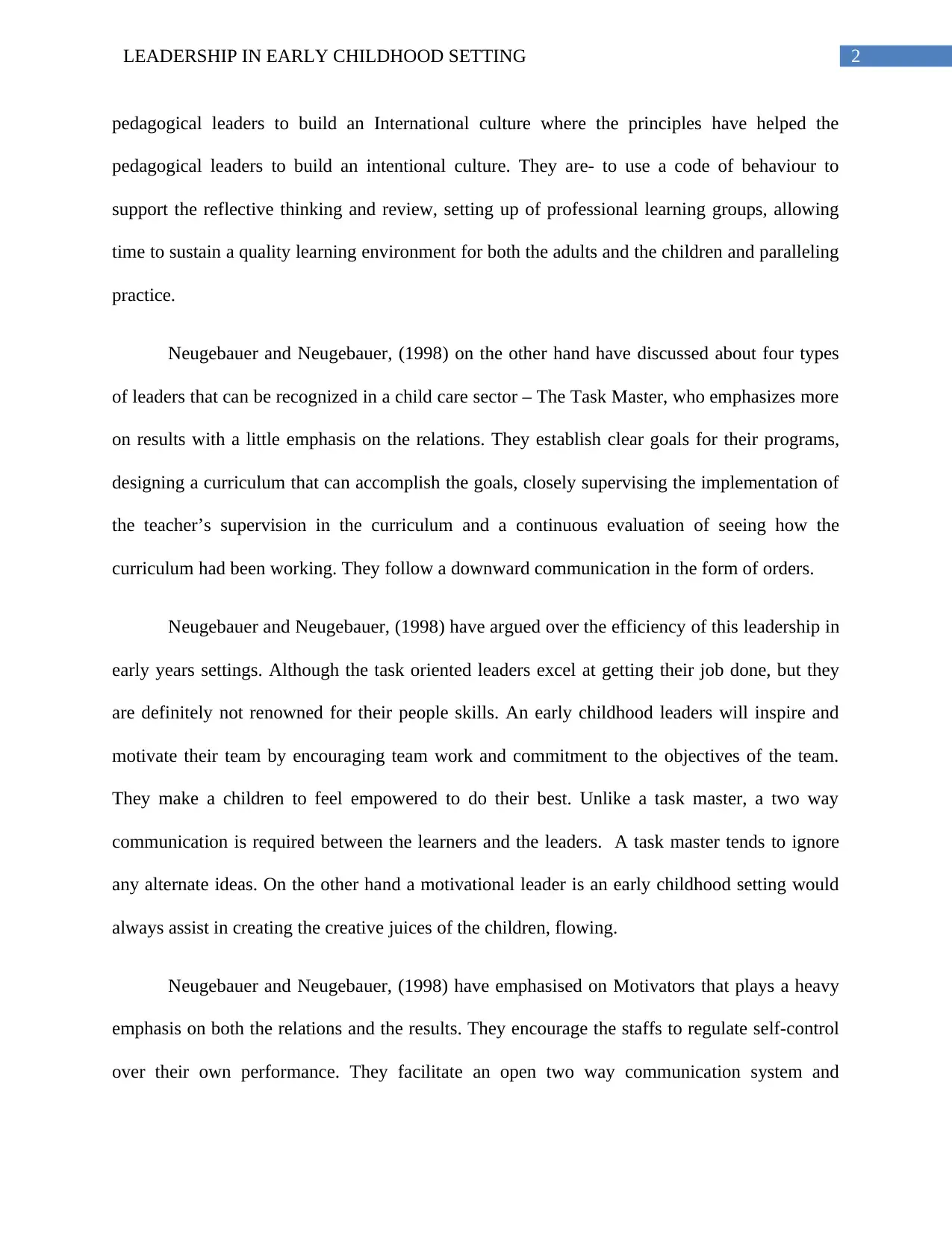
2LEADERSHIP IN EARLY CHILDHOOD SETTING
pedagogical leaders to build an International culture where the principles have helped the
pedagogical leaders to build an intentional culture. They are- to use a code of behaviour to
support the reflective thinking and review, setting up of professional learning groups, allowing
time to sustain a quality learning environment for both the adults and the children and paralleling
practice.
Neugebauer and Neugebauer, (1998) on the other hand have discussed about four types
of leaders that can be recognized in a child care sector – The Task Master, who emphasizes more
on results with a little emphasis on the relations. They establish clear goals for their programs,
designing a curriculum that can accomplish the goals, closely supervising the implementation of
the teacher’s supervision in the curriculum and a continuous evaluation of seeing how the
curriculum had been working. They follow a downward communication in the form of orders.
Neugebauer and Neugebauer, (1998) have argued over the efficiency of this leadership in
early years settings. Although the task oriented leaders excel at getting their job done, but they
are definitely not renowned for their people skills. An early childhood leaders will inspire and
motivate their team by encouraging team work and commitment to the objectives of the team.
They make a children to feel empowered to do their best. Unlike a task master, a two way
communication is required between the learners and the leaders. A task master tends to ignore
any alternate ideas. On the other hand a motivational leader is an early childhood setting would
always assist in creating the creative juices of the children, flowing.
Neugebauer and Neugebauer, (1998) have emphasised on Motivators that plays a heavy
emphasis on both the relations and the results. They encourage the staffs to regulate self-control
over their own performance. They facilitate an open two way communication system and
pedagogical leaders to build an International culture where the principles have helped the
pedagogical leaders to build an intentional culture. They are- to use a code of behaviour to
support the reflective thinking and review, setting up of professional learning groups, allowing
time to sustain a quality learning environment for both the adults and the children and paralleling
practice.
Neugebauer and Neugebauer, (1998) on the other hand have discussed about four types
of leaders that can be recognized in a child care sector – The Task Master, who emphasizes more
on results with a little emphasis on the relations. They establish clear goals for their programs,
designing a curriculum that can accomplish the goals, closely supervising the implementation of
the teacher’s supervision in the curriculum and a continuous evaluation of seeing how the
curriculum had been working. They follow a downward communication in the form of orders.
Neugebauer and Neugebauer, (1998) have argued over the efficiency of this leadership in
early years settings. Although the task oriented leaders excel at getting their job done, but they
are definitely not renowned for their people skills. An early childhood leaders will inspire and
motivate their team by encouraging team work and commitment to the objectives of the team.
They make a children to feel empowered to do their best. Unlike a task master, a two way
communication is required between the learners and the leaders. A task master tends to ignore
any alternate ideas. On the other hand a motivational leader is an early childhood setting would
always assist in creating the creative juices of the children, flowing.
Neugebauer and Neugebauer, (1998) have emphasised on Motivators that plays a heavy
emphasis on both the relations and the results. They encourage the staffs to regulate self-control
over their own performance. They facilitate an open two way communication system and
⊘ This is a preview!⊘
Do you want full access?
Subscribe today to unlock all pages.

Trusted by 1+ million students worldwide
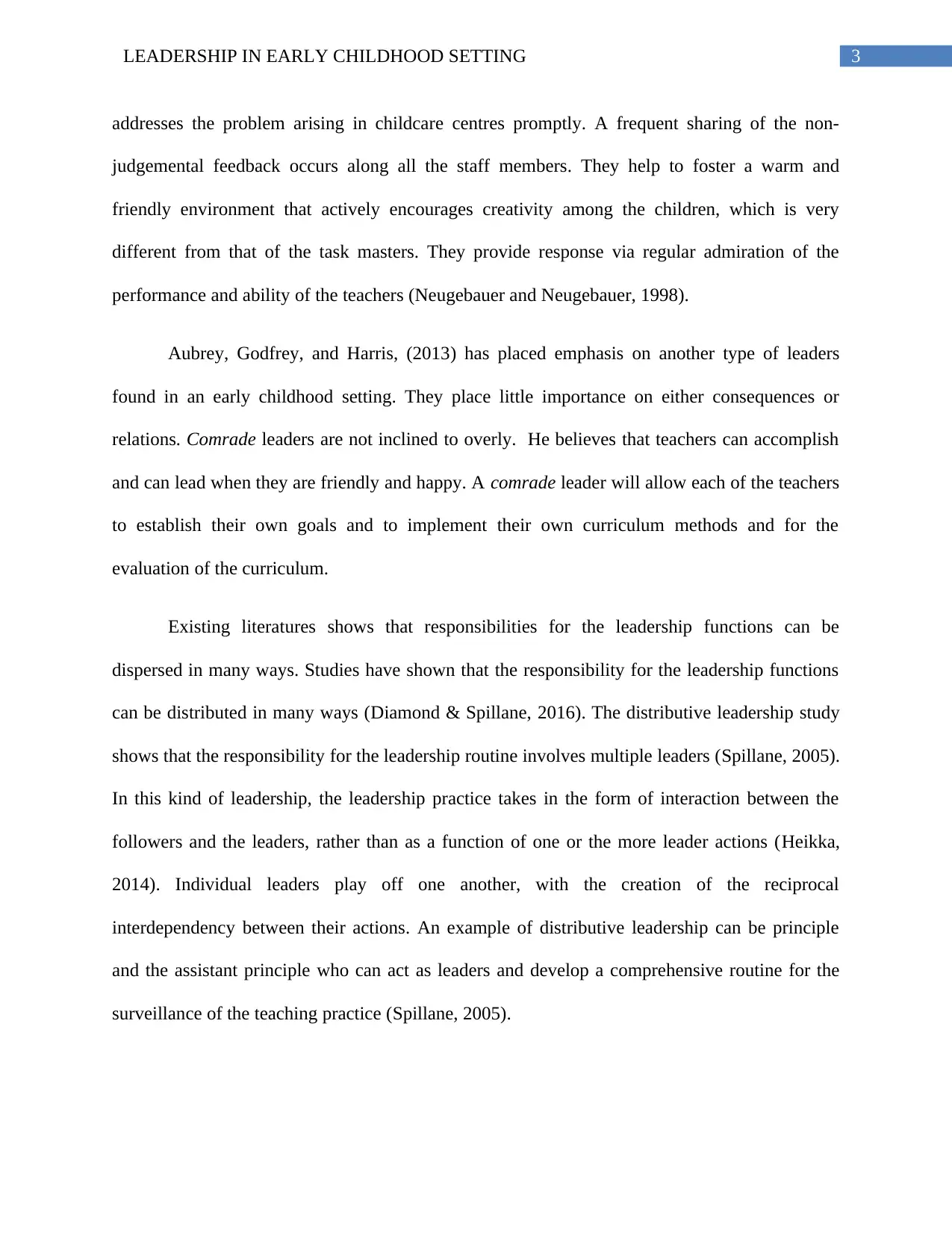
3LEADERSHIP IN EARLY CHILDHOOD SETTING
addresses the problem arising in childcare centres promptly. A frequent sharing of the non-
judgemental feedback occurs along all the staff members. They help to foster a warm and
friendly environment that actively encourages creativity among the children, which is very
different from that of the task masters. They provide response via regular admiration of the
performance and ability of the teachers (Neugebauer and Neugebauer, 1998).
Aubrey, Godfrey, and Harris, (2013) has placed emphasis on another type of leaders
found in an early childhood setting. They place little importance on either consequences or
relations. Comrade leaders are not inclined to overly. He believes that teachers can accomplish
and can lead when they are friendly and happy. A comrade leader will allow each of the teachers
to establish their own goals and to implement their own curriculum methods and for the
evaluation of the curriculum.
Existing literatures shows that responsibilities for the leadership functions can be
dispersed in many ways. Studies have shown that the responsibility for the leadership functions
can be distributed in many ways (Diamond & Spillane, 2016). The distributive leadership study
shows that the responsibility for the leadership routine involves multiple leaders (Spillane, 2005).
In this kind of leadership, the leadership practice takes in the form of interaction between the
followers and the leaders, rather than as a function of one or the more leader actions (Heikka,
2014). Individual leaders play off one another, with the creation of the reciprocal
interdependency between their actions. An example of distributive leadership can be principle
and the assistant principle who can act as leaders and develop a comprehensive routine for the
surveillance of the teaching practice (Spillane, 2005).
addresses the problem arising in childcare centres promptly. A frequent sharing of the non-
judgemental feedback occurs along all the staff members. They help to foster a warm and
friendly environment that actively encourages creativity among the children, which is very
different from that of the task masters. They provide response via regular admiration of the
performance and ability of the teachers (Neugebauer and Neugebauer, 1998).
Aubrey, Godfrey, and Harris, (2013) has placed emphasis on another type of leaders
found in an early childhood setting. They place little importance on either consequences or
relations. Comrade leaders are not inclined to overly. He believes that teachers can accomplish
and can lead when they are friendly and happy. A comrade leader will allow each of the teachers
to establish their own goals and to implement their own curriculum methods and for the
evaluation of the curriculum.
Existing literatures shows that responsibilities for the leadership functions can be
dispersed in many ways. Studies have shown that the responsibility for the leadership functions
can be distributed in many ways (Diamond & Spillane, 2016). The distributive leadership study
shows that the responsibility for the leadership routine involves multiple leaders (Spillane, 2005).
In this kind of leadership, the leadership practice takes in the form of interaction between the
followers and the leaders, rather than as a function of one or the more leader actions (Heikka,
2014). Individual leaders play off one another, with the creation of the reciprocal
interdependency between their actions. An example of distributive leadership can be principle
and the assistant principle who can act as leaders and develop a comprehensive routine for the
surveillance of the teaching practice (Spillane, 2005).
Paraphrase This Document
Need a fresh take? Get an instant paraphrase of this document with our AI Paraphraser
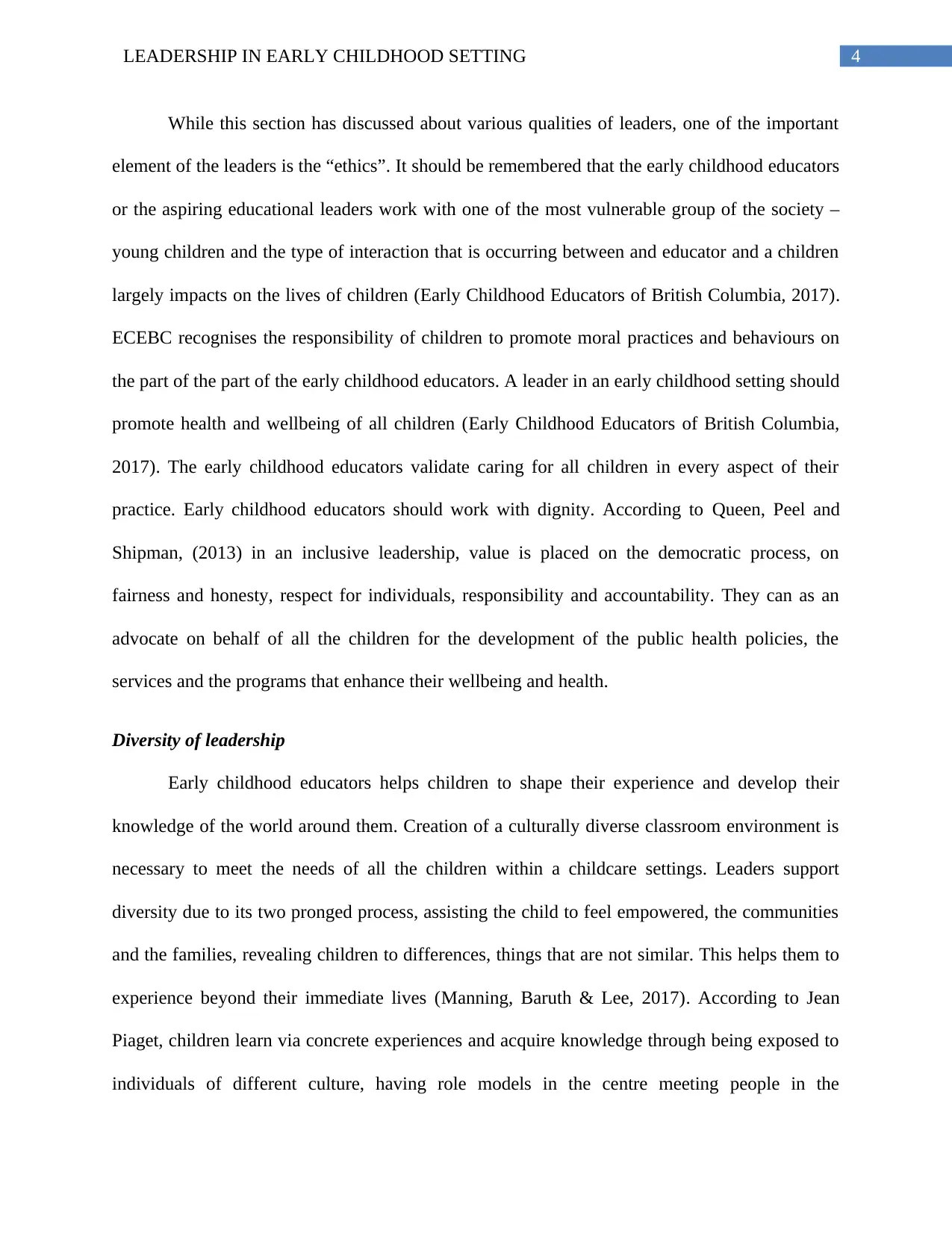
4LEADERSHIP IN EARLY CHILDHOOD SETTING
While this section has discussed about various qualities of leaders, one of the important
element of the leaders is the “ethics”. It should be remembered that the early childhood educators
or the aspiring educational leaders work with one of the most vulnerable group of the society –
young children and the type of interaction that is occurring between and educator and a children
largely impacts on the lives of children (Early Childhood Educators of British Columbia, 2017).
ECEBC recognises the responsibility of children to promote moral practices and behaviours on
the part of the part of the early childhood educators. A leader in an early childhood setting should
promote health and wellbeing of all children (Early Childhood Educators of British Columbia,
2017). The early childhood educators validate caring for all children in every aspect of their
practice. Early childhood educators should work with dignity. According to Queen, Peel and
Shipman, (2013) in an inclusive leadership, value is placed on the democratic process, on
fairness and honesty, respect for individuals, responsibility and accountability. They can as an
advocate on behalf of all the children for the development of the public health policies, the
services and the programs that enhance their wellbeing and health.
Diversity of leadership
Early childhood educators helps children to shape their experience and develop their
knowledge of the world around them. Creation of a culturally diverse classroom environment is
necessary to meet the needs of all the children within a childcare settings. Leaders support
diversity due to its two pronged process, assisting the child to feel empowered, the communities
and the families, revealing children to differences, things that are not similar. This helps them to
experience beyond their immediate lives (Manning, Baruth & Lee, 2017). According to Jean
Piaget, children learn via concrete experiences and acquire knowledge through being exposed to
individuals of different culture, having role models in the centre meeting people in the
While this section has discussed about various qualities of leaders, one of the important
element of the leaders is the “ethics”. It should be remembered that the early childhood educators
or the aspiring educational leaders work with one of the most vulnerable group of the society –
young children and the type of interaction that is occurring between and educator and a children
largely impacts on the lives of children (Early Childhood Educators of British Columbia, 2017).
ECEBC recognises the responsibility of children to promote moral practices and behaviours on
the part of the part of the early childhood educators. A leader in an early childhood setting should
promote health and wellbeing of all children (Early Childhood Educators of British Columbia,
2017). The early childhood educators validate caring for all children in every aspect of their
practice. Early childhood educators should work with dignity. According to Queen, Peel and
Shipman, (2013) in an inclusive leadership, value is placed on the democratic process, on
fairness and honesty, respect for individuals, responsibility and accountability. They can as an
advocate on behalf of all the children for the development of the public health policies, the
services and the programs that enhance their wellbeing and health.
Diversity of leadership
Early childhood educators helps children to shape their experience and develop their
knowledge of the world around them. Creation of a culturally diverse classroom environment is
necessary to meet the needs of all the children within a childcare settings. Leaders support
diversity due to its two pronged process, assisting the child to feel empowered, the communities
and the families, revealing children to differences, things that are not similar. This helps them to
experience beyond their immediate lives (Manning, Baruth & Lee, 2017). According to Jean
Piaget, children learn via concrete experiences and acquire knowledge through being exposed to
individuals of different culture, having role models in the centre meeting people in the
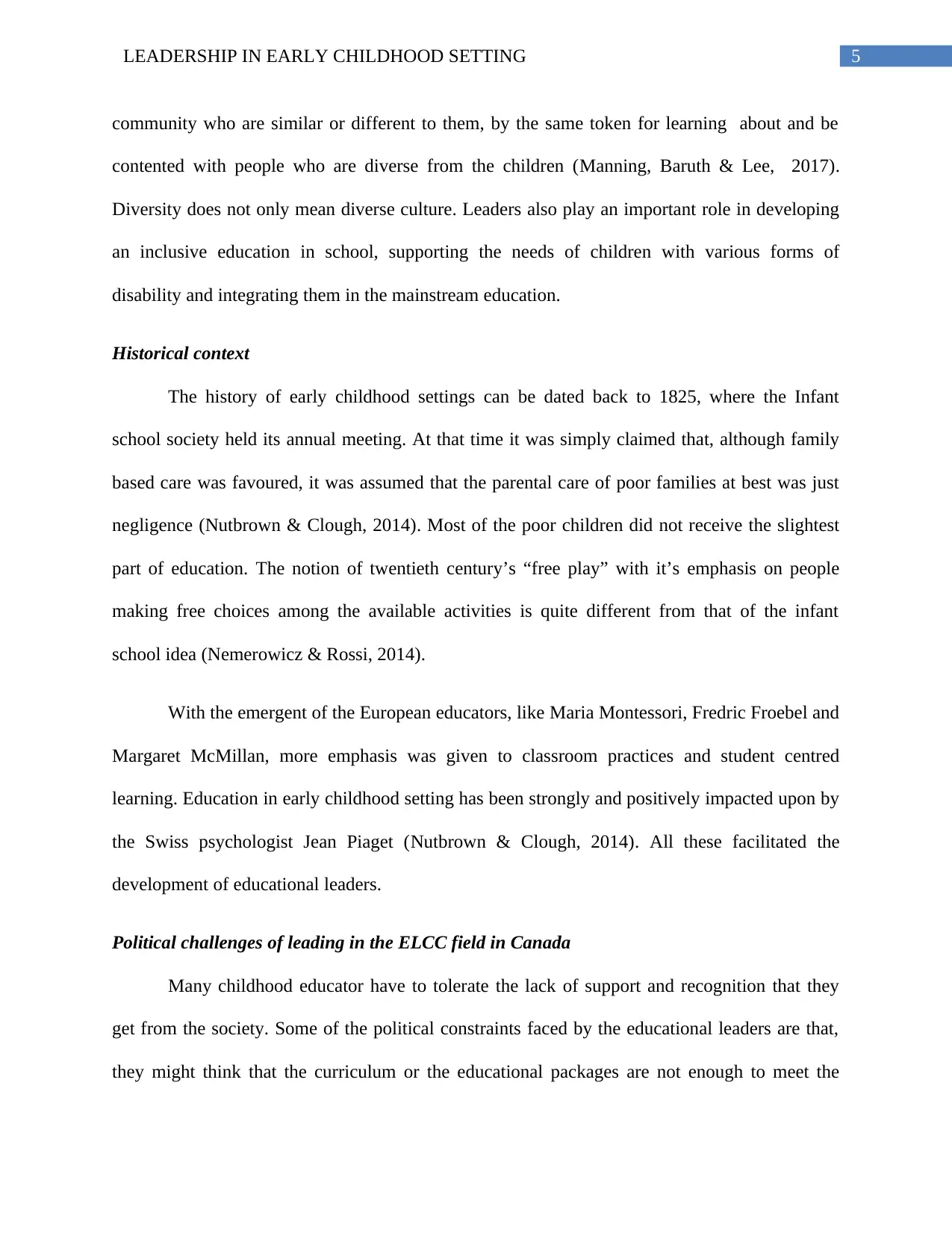
5LEADERSHIP IN EARLY CHILDHOOD SETTING
community who are similar or different to them, by the same token for learning about and be
contented with people who are diverse from the children (Manning, Baruth & Lee, 2017).
Diversity does not only mean diverse culture. Leaders also play an important role in developing
an inclusive education in school, supporting the needs of children with various forms of
disability and integrating them in the mainstream education.
Historical context
The history of early childhood settings can be dated back to 1825, where the Infant
school society held its annual meeting. At that time it was simply claimed that, although family
based care was favoured, it was assumed that the parental care of poor families at best was just
negligence (Nutbrown & Clough, 2014). Most of the poor children did not receive the slightest
part of education. The notion of twentieth century’s “free play” with it’s emphasis on people
making free choices among the available activities is quite different from that of the infant
school idea (Nemerowicz & Rossi, 2014).
With the emergent of the European educators, like Maria Montessori, Fredric Froebel and
Margaret McMillan, more emphasis was given to classroom practices and student centred
learning. Education in early childhood setting has been strongly and positively impacted upon by
the Swiss psychologist Jean Piaget (Nutbrown & Clough, 2014). All these facilitated the
development of educational leaders.
Political challenges of leading in the ELCC field in Canada
Many childhood educator have to tolerate the lack of support and recognition that they
get from the society. Some of the political constraints faced by the educational leaders are that,
they might think that the curriculum or the educational packages are not enough to meet the
community who are similar or different to them, by the same token for learning about and be
contented with people who are diverse from the children (Manning, Baruth & Lee, 2017).
Diversity does not only mean diverse culture. Leaders also play an important role in developing
an inclusive education in school, supporting the needs of children with various forms of
disability and integrating them in the mainstream education.
Historical context
The history of early childhood settings can be dated back to 1825, where the Infant
school society held its annual meeting. At that time it was simply claimed that, although family
based care was favoured, it was assumed that the parental care of poor families at best was just
negligence (Nutbrown & Clough, 2014). Most of the poor children did not receive the slightest
part of education. The notion of twentieth century’s “free play” with it’s emphasis on people
making free choices among the available activities is quite different from that of the infant
school idea (Nemerowicz & Rossi, 2014).
With the emergent of the European educators, like Maria Montessori, Fredric Froebel and
Margaret McMillan, more emphasis was given to classroom practices and student centred
learning. Education in early childhood setting has been strongly and positively impacted upon by
the Swiss psychologist Jean Piaget (Nutbrown & Clough, 2014). All these facilitated the
development of educational leaders.
Political challenges of leading in the ELCC field in Canada
Many childhood educator have to tolerate the lack of support and recognition that they
get from the society. Some of the political constraints faced by the educational leaders are that,
they might think that the curriculum or the educational packages are not enough to meet the
⊘ This is a preview!⊘
Do you want full access?
Subscribe today to unlock all pages.

Trusted by 1+ million students worldwide
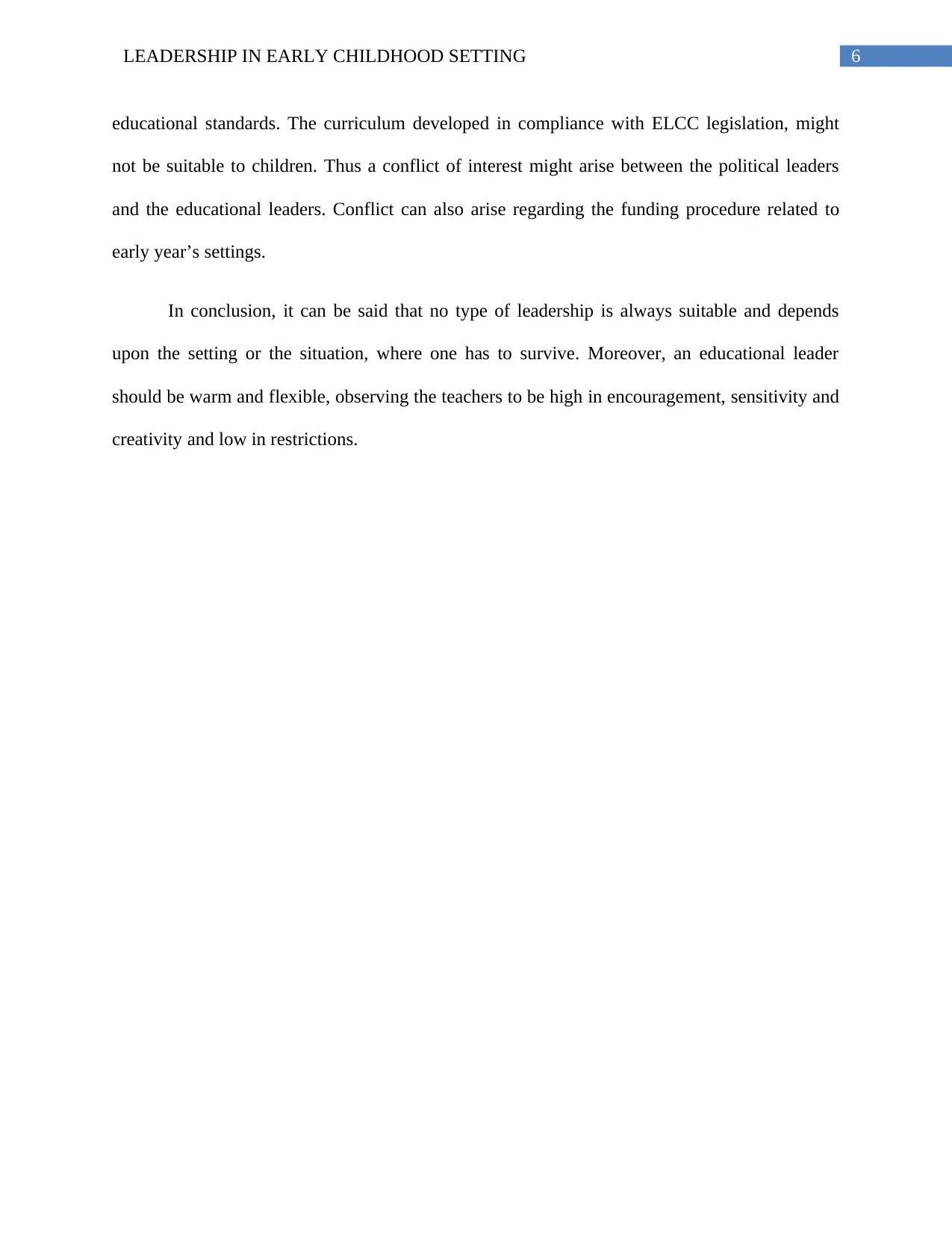
6LEADERSHIP IN EARLY CHILDHOOD SETTING
educational standards. The curriculum developed in compliance with ELCC legislation, might
not be suitable to children. Thus a conflict of interest might arise between the political leaders
and the educational leaders. Conflict can also arise regarding the funding procedure related to
early year’s settings.
In conclusion, it can be said that no type of leadership is always suitable and depends
upon the setting or the situation, where one has to survive. Moreover, an educational leader
should be warm and flexible, observing the teachers to be high in encouragement, sensitivity and
creativity and low in restrictions.
educational standards. The curriculum developed in compliance with ELCC legislation, might
not be suitable to children. Thus a conflict of interest might arise between the political leaders
and the educational leaders. Conflict can also arise regarding the funding procedure related to
early year’s settings.
In conclusion, it can be said that no type of leadership is always suitable and depends
upon the setting or the situation, where one has to survive. Moreover, an educational leader
should be warm and flexible, observing the teachers to be high in encouragement, sensitivity and
creativity and low in restrictions.
Paraphrase This Document
Need a fresh take? Get an instant paraphrase of this document with our AI Paraphraser
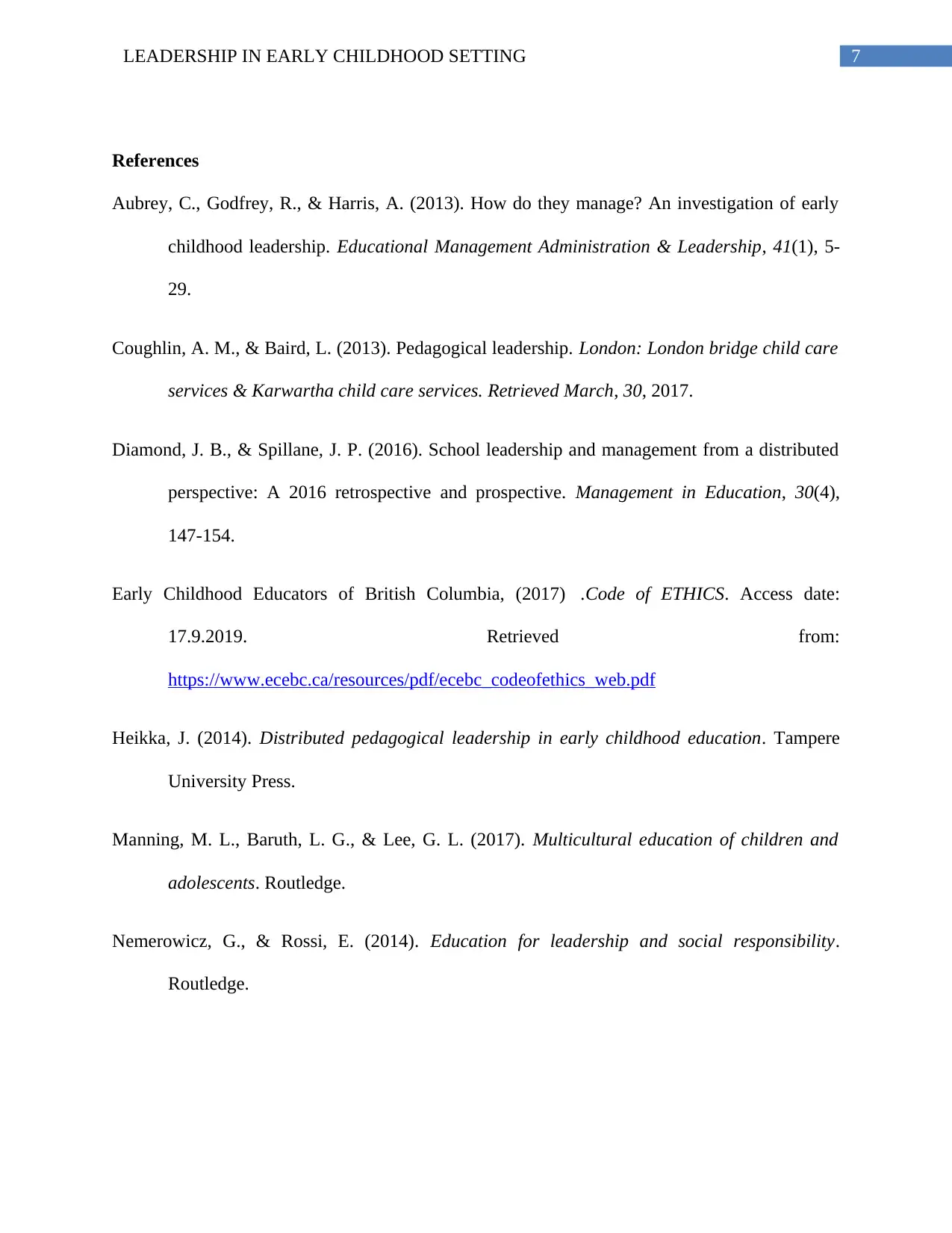
7LEADERSHIP IN EARLY CHILDHOOD SETTING
References
Aubrey, C., Godfrey, R., & Harris, A. (2013). How do they manage? An investigation of early
childhood leadership. Educational Management Administration & Leadership, 41(1), 5-
29.
Coughlin, A. M., & Baird, L. (2013). Pedagogical leadership. London: London bridge child care
services & Karwartha child care services. Retrieved March, 30, 2017.
Diamond, J. B., & Spillane, J. P. (2016). School leadership and management from a distributed
perspective: A 2016 retrospective and prospective. Management in Education, 30(4),
147-154.
Early Childhood Educators of British Columbia, (2017) .Code of ETHICS. Access date:
17.9.2019. Retrieved from:
https://www.ecebc.ca/resources/pdf/ecebc_codeofethics_web.pdf
Heikka, J. (2014). Distributed pedagogical leadership in early childhood education. Tampere
University Press.
Manning, M. L., Baruth, L. G., & Lee, G. L. (2017). Multicultural education of children and
adolescents. Routledge.
Nemerowicz, G., & Rossi, E. (2014). Education for leadership and social responsibility.
Routledge.
References
Aubrey, C., Godfrey, R., & Harris, A. (2013). How do they manage? An investigation of early
childhood leadership. Educational Management Administration & Leadership, 41(1), 5-
29.
Coughlin, A. M., & Baird, L. (2013). Pedagogical leadership. London: London bridge child care
services & Karwartha child care services. Retrieved March, 30, 2017.
Diamond, J. B., & Spillane, J. P. (2016). School leadership and management from a distributed
perspective: A 2016 retrospective and prospective. Management in Education, 30(4),
147-154.
Early Childhood Educators of British Columbia, (2017) .Code of ETHICS. Access date:
17.9.2019. Retrieved from:
https://www.ecebc.ca/resources/pdf/ecebc_codeofethics_web.pdf
Heikka, J. (2014). Distributed pedagogical leadership in early childhood education. Tampere
University Press.
Manning, M. L., Baruth, L. G., & Lee, G. L. (2017). Multicultural education of children and
adolescents. Routledge.
Nemerowicz, G., & Rossi, E. (2014). Education for leadership and social responsibility.
Routledge.
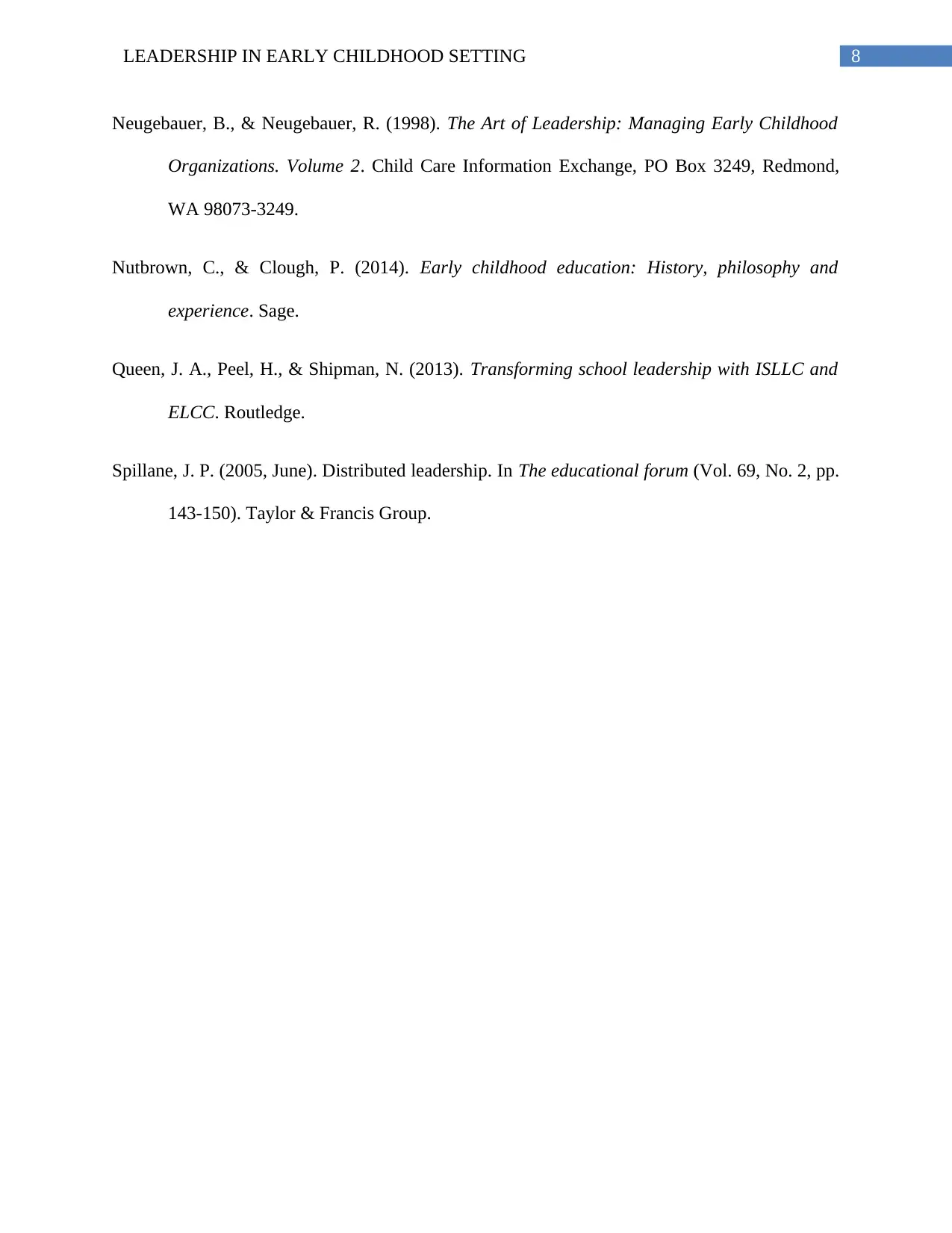
8LEADERSHIP IN EARLY CHILDHOOD SETTING
Neugebauer, B., & Neugebauer, R. (1998). The Art of Leadership: Managing Early Childhood
Organizations. Volume 2. Child Care Information Exchange, PO Box 3249, Redmond,
WA 98073-3249.
Nutbrown, C., & Clough, P. (2014). Early childhood education: History, philosophy and
experience. Sage.
Queen, J. A., Peel, H., & Shipman, N. (2013). Transforming school leadership with ISLLC and
ELCC. Routledge.
Spillane, J. P. (2005, June). Distributed leadership. In The educational forum (Vol. 69, No. 2, pp.
143-150). Taylor & Francis Group.
Neugebauer, B., & Neugebauer, R. (1998). The Art of Leadership: Managing Early Childhood
Organizations. Volume 2. Child Care Information Exchange, PO Box 3249, Redmond,
WA 98073-3249.
Nutbrown, C., & Clough, P. (2014). Early childhood education: History, philosophy and
experience. Sage.
Queen, J. A., Peel, H., & Shipman, N. (2013). Transforming school leadership with ISLLC and
ELCC. Routledge.
Spillane, J. P. (2005, June). Distributed leadership. In The educational forum (Vol. 69, No. 2, pp.
143-150). Taylor & Francis Group.
⊘ This is a preview!⊘
Do you want full access?
Subscribe today to unlock all pages.

Trusted by 1+ million students worldwide
1 out of 9
Related Documents
Your All-in-One AI-Powered Toolkit for Academic Success.
+13062052269
info@desklib.com
Available 24*7 on WhatsApp / Email
![[object Object]](/_next/static/media/star-bottom.7253800d.svg)
Unlock your academic potential
Copyright © 2020–2025 A2Z Services. All Rights Reserved. Developed and managed by ZUCOL.





